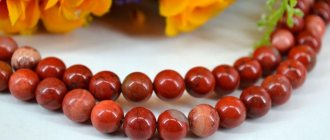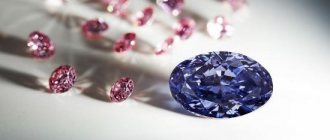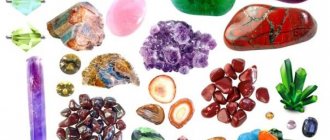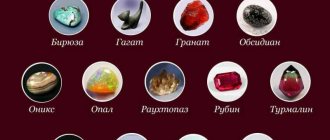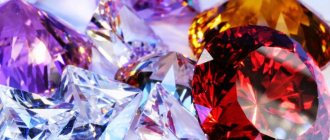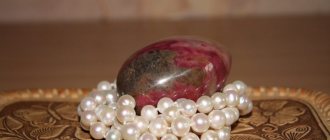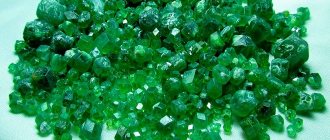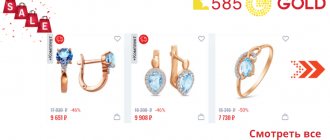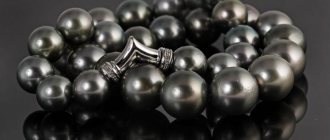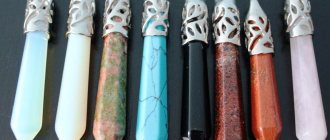Stones also have character
Stones, as part of the ecosystem, are considered by science to be inanimate nature. But adherents of the paranormal are sure: each gem is endowed with its own character.
Astromineralogists believe that minerals are in tune with the elements - Water, Air, Earth, Fire:
- Airy ones are translucent, with a bit of heterogeneity, haze, and impurities.
- Almost all representatives of Fire are transparent and pure.
- Water gems are translucent and of medium hardness; These are all stones of marine origin (coral, pearls).
- "Earthlings" are solid and opaque.
The doctrine of the combination of precious minerals was developed by the sages of Ancient India. A classic Indian artifact is the navara. This is an accessory made of nine stones with different characteristics (but not warring). Each one represents a planet of the solar system and is endowed with part of its power. As a result, their total magical power increases exponentially. The owner of the jewelry receives bonuses in the form of health, luck, and personal happiness.
Amethyst
A luxurious semi-precious variety of quartz was known back in Ancient Egypt: powerful pharaohs decorated their clothes and hats with it. The Romans called the translucent purple stone the blessed stone, and the Christians proudly called it apostolic or episcopal, since it was often seen in the vestments of high priests.
Magical properties of amethyst
Amethyst helps people overcome addictions: it is an ideal ally in the fight against alcoholism and drug addiction. In ancient Rome, not a single merry feast was complete without amethysts: it was believed that it reduced the percentage of alcohol in the blood and sobered up, allowing guests to have fun longer than usual.
Amethyst is a symbol of balance and inner peace, allowing a person to realize his potential, eliminating unnecessary mental doubts and anxieties, imparting confidence that is easily read by people around him.
How to wear amethyst
Amethyst should never be worn as a single piece of jewelry: this leads to loneliness and mental anxieties. Amethyst also does not like proximity to other gems, in which case the consequences can be the most unexpected.
The ideal tandem is earrings and a ring with amethysts in a silver frame (it is also possible to use gold, but such sets are very rare). Amethysts are best suited for Scorpios, Pisces and Aquarius.
Why is their “relationship” important for humans?
In astrology, the compatibility of minerals with each other is based on the thesis of harmony or antagonism (hostility) of the elements and planets. Everything is like people.
The compatibility of gemstones of the first row is especially problematic. Diamond, sapphire, ruby, alexandrite can hardly be tolerated by their neighbors.
Therefore, when choosing jewelry, it is worth considering the compatibility of some stones with others:
- The elements of a person and a gem must coincide or be combined.
- Stones of the same element enhance each other's effect.
- It is forbidden to wear minerals of the opposite zodiac sign.
- Gems of antagonistic elements cannot be worn together in an accessory or outfit.
An Air person can wear Fire stones, while an “Earthman” can wear Water minerals.
They are at odds with each other:
- Fire - Earth. The fire will suppress the earthling. In response, he will take revenge or simply “close down.” That is, as a magical artifact it will become useless.
- Fire water. Water extinguishes Fire, but it evaporates.
- Air - Water. They create an intersection of vibrations that is uncomfortable for the owner.
Stones cannot be worn at random. Their compatibility in jewelry is especially important.
By putting on a necklace, bracelet or earrings, a person becomes involved in the relationship between gems at the energy-informational level. If compatibility is negative, the energy gets confused and becomes chaotic. A “beating” effect occurs. And the owner gets problems - he gets sick or becomes unlucky.
The importance of compatibility
Lovers of jewelry with precious and semi-precious stones unwittingly enter into a relationship with their energy. The impact on each person is different. Light pearls are suitable for some, dark garnet for others, and a serpentine resembling the skin of a reptile for others.
Details in the articles “How to recognize your gemstone by date of birth and name” and “Talisman stones by zodiac sign”.
When several types of different stones are present in a piece of jewelry, they also enter into relationships with each other. And the influence of energy drinks is not always combined beneficially. After all, minerals are born in different conditions. Fire worked to create some of them, while others were sculpted by water or wind over millions of years. Some lay in the ground, absorbing additives and acquiring color.
As a result, when, for example, diamond and malachite are placed side by side in the same frame, a “conflict of interests” between Fire and Earth begins. Instead of working for the benefit of the owner, charging him with positive emotions. Stones that are incompatible with each other “by nature” waste energy on unnecessary struggle.
How to find your stones
The number of mineral samples is in the hundreds. To organize them from a magical point of view, astrologers, gemologists and jewelers have developed a compatibility table.
It’s convenient and easy to work with:
- Find a gem that matches your zodiac sign.
- From the list of minerals compatible with it, those that are also suitable according to the recommendations of astrologers are selected.
- You can choose neutral options, that is, not prohibited by the horoscope.
A table of zodiac signs and their corresponding talisman stones according to the horoscope, so that in the future it will be easier to determine the compatibility of minerals with each other.
| Date of Birth | Zodiac sign | Stone |
| March 21 – April 20 | Aries | agate, amethyst, garnet, pearl, diamond, ruby, serpentine, carnelian, hawkeye and jasper |
| April 21 – May 21 | Taurus | emerald, onyx, rose quartz, ruby, carnelian, jasper, malachite, agate, chrysoprase, aventurine |
| May 22 – June 21 | Twins | sapphire, agate, jasper, crystal, coral, turquoise, emerald, beryl, carnelian, alexandrite, topaz |
| June 22 – July 22 | Cancer | agate, adularia, onyx, opal, obsidian, emerald, pearl, moonstone, emerald, aquamarine |
| July 23 – August 23 | a lion | garnet, bull's eye, emerald, citrine, jasper, ruby, opal, topaz, amber, carnelian, peridot |
| August 24 – September 23 | Virgo | rock crystal, chrysopass, onyx, opal, jade, carnelian, diamond, sapphire, jasper, sultanite |
| September 24 – October 23 | Scales | opal, jade, rhodonite, malachite, crystal, jasper, agate, olivine, citrine, amethyst, tourmaline |
| October 24 – November 22 | Scorpion | garnet, malachite, jasper, chrysoprase, coral, agate, adularia, tiger eye, turquoise, serpentine |
| November 23 – December 21 | Sagittarius | emerald, turquoise, hyacinth, olivine, amber, carbuncle, opal, topaz, blue quartz |
| December 22 – January 20 | Capricorn | onyx, garnet, cat's eye, tiger's eye, opal, turquoise, olivine, ruby, green malachite |
| January 21 – February 20 | Aquarius | turquoise, garnet, carnelian, agate, pearl, crystal, citrine, jasper, amethyst, lapis lazuli, jade |
| February 21 – March 20 | Fish | pearls, opal, adularia, hawkeye, peridot, turquoise, amethyst, emerald, alexandrite |
The compatibility chart below presents common, affordable and more exotic minerals, which can help you determine whether the stones are compatible with each other depending on their properties.
| Stones | Harmonious combination | Forbidden combination | Questionable combination | Neutral relationship |
| Diamond, aventurine, ruby, hyacinth, carbuncle, heliotrope, chrysoprase, peridot | White pearl, turquoise, beryl, agate, emerald, lapis lazuli, alabaster, sapphire, coral, carnelian, amethyst | Onyx, obsidian, malachite, sardonyx, marcasite | Rock crystal, garnet, jasper, moonstone, aquamarine, opal, bloodstone, ruby | Carnelian, golden topaz |
| Beryl, crystal, opal, moonstone, coral, aquamarine | Amethyst, turquoise, alabaster, blue and blue sapphire, onyx, lapis lazuli, labradorite, white pearl | Heliotrope, garnet, ruby, jasper, chalcedony, agate, bloodstone, carnelian, malachite, chalcedony | Diamond, emerald hyacinth, peridot, aventurine, topaz | Amber and obsidian |
| Golden topaz, variegated agate, carnelian, emerald | White pearl, agate, dark and blue sapphire, turquoise, amber, jasper, alabaster, emerald, sardonyx, chalcedony, amber, light topaz, lapis lazuli | Beryl, moonstone, coral, aquamarine, opal | Diamond, hyacinth, ruby, dark topaz, aventurine, giliotrope, amethyst, chrysoprase and peridot | Obsidian, rock crystal, labradorite |
| White pearl, blue sapphire, alabaster, light agate, coral, turquoise, lapis lazuli and carnelian | Emerald, moonstone, garnet, aquamarine, amethyst, opal, chrysoprase, bloodstone, aventurine, jasper, hyacinth, turquoise, rock crystal | Malachite, beryl, sardonyx, marcasite | Jade, variegated agate, carnelian | Amber, dark topaz |
| Hematite, red garnet and jasper | Emerald, sapphire, bloodstone, alabaster, agate | Diamond, beryl, lapis lazuli, ruby, moonstone, pearl, hyacinth, aquamarine, heliotrope | Onyx, malachite and black agate | Variegated agate and carnelian |
| Black agate, sardonyx, onyx | Carnelian, golden topaz, emerald, variegated agate | Diamond, peridot, hyacinth, ruby, aventurine, heliotrope, carbuncle, chrysoprase | Pearl, beryl, coral, aquamarine, moonstone, turquoise | – |
| Jade, amber, topaz, light amethyst | Labradorite, golden topaz, rock crystal, emerald, opalescent moon mineral | Ruby, diamond | Beryl, aquamarine | – |
Another mineral compatibility table, this one is compiled based on the relationships of the planets with which they are connected.
| Stone | Favorable compatibility | Unfavorable compatibility | Inconsistent Compatibility | Neutral combination |
| Aventurine, diamond, zircon, ruby, chrysolite, chrysoprase | Agate, amethyst, white pearl, beryl, turquoise, emerald, coral, lapis lazuli, sapphire, carnelian | Malachite, onyx, obsidian, sardonyx | Aquamarine, garnet, rose quartz, heliotrope, moonstone, opal, jasper | Topaz |
| Aquamarine, beryl, rose quartz, coral, moonstone, opal | Amethyst, turquoise, pearls, labradorite, lapis lazuli, onyx, sapphire | Agate, garnet, heliodor, heliotrope, malachite, ruby, carnelian, jasper | Aventurine, diamond, zircon, emerald, topaz, peridot | Obsidian, amber |
| Garnet, hematite, jasper | Agate, emerald, heliotrope, sapphire | Aventurine, aquamarine, diamond, beryl, turquoise, heliodor, zircon, pearl, moonstone, lapis lazuli, ruby, peridot, chrysoprase | Malachite, onyx, black agate | Carnelian, moss agate |
| Onyx, sardonyx, dark agate | Golden topaz, emerald, carnelian, moss agate | Aventurine, diamond, heliodor, zircon, ruby, peridot, chrysoprase | Coral, moonstone | |
| Turquoise, blue sapphire, pearls, lapis lazuli, blue agate | Aventurine, aquamarine, diamond, amethyst, turquoise, heliodor, zircon, emerald, rose quartz, heliotrope, moonstone, opal, ruby, chrysoprase, jasper | Beryl, malachite, sardonyx | Moss agate, jade | Rauchtopaz, amber |
| Jade, amethyst, topaz, amber | Rock crystal, emerald, labradorite, moonstone | Beryl, malachite, sardonyx | Aquamarine |
Coincidence of the elements of man and stone
The elements of the stones that coexist in the decoration should not only be combined with each other. It is important that each one suits the person himself. And here the zodiac sign of the owner of the jewelry plays an important role. The rule is the same as for the compatibility of the minerals themselves.
Fire signs should not wear water stones - emerald, aquamarine, hematite. For beads and bracelets, combinations of lapis lazuli, amazonite, coral, and amber are suitable.
For people born under the water constellations Pisces, Cancer and Scorpio, it is allowed to simultaneously create compositions from jade, jadeite, jasper, labradorite and other stones of the earth element.
Airy natures (Libra, Gemini and Aquarius) can safely wear diamonds and sapphires, emerald and ruby, amethyst and hematite together. The list continues with Fire stones - spinel, zircon and almandine.
Incompatible stones
| alexandrite | barite kyanite siderite |
| amethyst | oriental topaz (yellow sapphire) coral red coral black magnesite spinel red emerald |
| turquoise | spessartine garnet spinel blue amber |
| hematite | sun stone |
| rhinestone | jadeite red jasper sodalite brown sepiolite |
| almandine garnet | amber |
| garnet pyrope | carnelian lepidocrocite pyrolusite pyrargyrite |
| spessartine garnet | turquoise magnetite sphalerite garnet almandine |
| pearl | zircon red coral white chalcopyrite |
| emerald | anabergin amethyst galena quartz blue azurite obsidian |
| Moonstone | rutile quartz lapis lazuli (lapis lazuli) |
| malachite | fluorite white mother of pearl galena |
| obsidian | tourmaline black emerald chrysoprase tourmaline yellow |
| onyx | fluorite green |
| ruby | tree opal azurite with pyrite |
| sodalite | rhinestone |
| unakite | siderite |
| white fluorite | cat's eye hematite red malachite quartz rutile |
| fluorite green | diamond (diamond) wolframite onyx |
| amber | benitoite turquoise magnetite sphalerite garnet almandine |
I hope this information will help you find your talisman stone.
Single stones that should not be worn in pairs
These are the stones that have quite strong energy itself, and it should not be increased. Symbols of power, strength, remarkable intelligence. They say that they give the owner physical and mental strength and increase performance.
* Jade - considered sacred in the East, capable of accumulating energy and helping its owner to act correctly in the most difficult situations.
* Malachite is also self-sufficient, but while it can still be worn with green shades of other gems, it should not be worn with red and blue ones. By the way, the Ring of Solomon looks very interesting with different shades of green - it is believed that it brings financial success.
* Black quartz - cannot be combined with anything else, is considered magical, complex and contradictory.
* Ruby is a royal stone, and it is better not to wear it in pairs, as it is powerful in itself, awakening passion and strength. He is often called the "Chief of the Gems", and the leader
there must still be one. But you can combine it with others, which is often done, especially in “All things pass and this shall pass” rings - for example, with diamonds.
How to distinguish a fake?
The risk of purchasing fake agate or its varieties is minimized. The prevalence and low cost of the stone do not justify such actions. A mineral refined through exposure to chemical solutions is not considered a fake. However, if you still want to buy a natural mineral with minimal processing, you should pay attention to the color of the stone - “poisonous” rich shades are not characteristic of natural agate.
Black agates are a rarer variety, so their imitation is often made from stone chips. It is very difficult to recognize such a fake with the naked eye. Try scratching glass with a stone or glass with a stone. Any natural agate is heavier and harder than glass. And even more so plastics.
As for a bracelet or beads, such a product will significantly weigh down the hand - natural minerals are weighty, and it is not without reason that they belong to the element of the Earth.
History and origin
Agate has been surrounded by many legends since its discovery. The first legends concern the origin of the stone. One version says that the mineral was found off the banks of the Achates River, which is located on the island of Sicily. According to the ancient scientist Pliny the Elder, it was the location of discovery that gave the mineral the name “agate.”
Another version says that the ancient Greeks gave the name to the gem, since translated from Greek the name of the stone means “happy, good, kind.”
It is true that other legends about the stone concern its unusual colors and fascinating patterns. Thus, agates with a pattern reminiscent of eyes gave rise to the legend of a celestial white eagle that fell to Earth and turned into stone after a battle with an evil sorcerer. After this, the stone became a symbol of the difference between good and evil.
The “big-eyed” gems were also called the “Eye of God.” More often this mention concerned the god Pluto or Vulcan. And ancient people placed stones processed into spherical shapes in the eye sockets of statues, believing that this would scare away evil forces.
The mentioned Pliny the Elder in his legends stated that agate has a beneficial effect on a person bitten by a spider or scorpion. The scientist also believed that medicine ground in an agate mortar facilitates the rapid treatment of diseases.
In fact, medieval healers used lotions of ground mineral with water to treat scorpion or snake bites, and alchemists of the same time made mortars and pestles from the gem. This ancient tradition has survived to this day, improved by modern technologies - laboratory containers are made from the gem.
The Italian Renaissance brought agate fame as a talisman for sculptors, craftsmen, artists, jewelers and other artisans. Any utensils and decorative items that decorated the houses of noble nobles and rulers were made from the mineral.
Did you know that one of the Vienna museums houses the largest agate product - an almost flat dish cut from a single nugget. The diameter of the rarity is 75 cm.
Thus, stone products gained popularity among the Byzantine basileus, and two centuries later, the Habsburg dynasty from Austria introduced a fashion for agate decorative items at court.
The properties of the mineral allow for very fine processing, due to which our ancestors considered agate a precious stone, and not an ornamental one. And mythology talks about agate as a symbol of good health, longevity and prosperity.
Magical properties of the mineral
Given the existing variety of agate varieties, it is quite difficult to generalize the magical power of this stone. Any effect on a person directly depends on the subtype of the mineral:
- White agate symbolizes kindness, calmness, and confidence, endowing the owner with these qualities. It is also a children's talisman that can improve health and protect the child from the evil eye. To do this, the amulet is hung above the crib.
White Agate - Gems of red or brown colors have the ability to show the owner the real world, taking off the dreamer's rose-colored glasses. Since ancient times, such a stone was considered a talisman for travelers or sailors, helping the wanderer to return home. In addition, brown minerals are protectors from troubles. Such amulets focus on survival in case of danger. And red agate attracts love and family well-being to the owner.
Red and brown - The blue nugget is a talisman of creativity. This is the stone of artists, musicians, other artists, as well as timid and insecure individuals. This mineral helps you think clearly and promotes self-expression.
Blue - Black agate is a stone of magic. This is an assistant to people endowed with supernatural abilities, helping to establish contacts with higher dimensions, including the other world.
Black - Yellow-brown stones reveal the gift of persuasion in a person and increase charisma. Serves as a talisman during long journeys.
Yellow-brown - The green mineral makes the owner attractive to others, endowing him with good luck in matters related to asserting his rights.
Green - Purple stone is aimed at increasing concentration, which is necessary during meditation.
Violet - The pink mineral helps people who have experienced unhappiness in love or other life shocks. By healing heart wounds, the stone restores the internal harmony of the owner, helping to find happiness in the future.
Pink - Gray agate favors down-to-earth individuals who seek themselves not in lofty matters, but in simpler ones - the desire to succeed in their career, accumulate finances, etc. The stone helps the owner concentrate his attention on the tasks at hand.
Grey - Blue mineral (sapphirite), on the contrary, is a stone of romantic natures who do not tolerate everyday routine. Such a talisman helps the owner cope with difficulties, pointing out the positive aspects of seemingly boring everyday things.
Blue
Thus, agate is a mineral that directs all the energy of the Earth to protect, calm, direct thoughts and concentrate the owner’s attention. With such a talisman, a person will be able to mentally encounter the real world, leaving the world of dreams, and achieve his goals under the reliable magical protection of the gem.
Compatibility with names and Zodiac
If you choose an agate talisman, it is important to find out whether it suits your name and horoscope. Agate does not have any preferences in terms of the personal qualities of the owner, so such a talisman can be safely chosen based on compatibility by Zodiac or name.
Names
Agate, as well as its independent varieties, are excellent for people named by the following names:
- Zhanna. Onyx is perfect for her, as it wards off troubles and promotes proper concentration and energy direction.
- Anatoly. The gem will bring him good luck, awaken his imagination, help him make decisions, protecting him from deceit.
- Clara. Agate will protect such a girl from deception, give her peace of mind, and strengthen her body and mind.
- Dmitriy. The mineral will help this man to suppress outbursts of rage and find a way out that is more suitable in the current situation.
- Lyudmila. For her, agate is a symbol of kindness, gentleness, calmness, and a protector of physical health.
- Makar. Onyx can protect him from dangers. This mineral will give Dmitry inner harmony, relieving him of depression and dark thoughts.
Zodiac signs
Astrologers clearly attribute agate to the patrons of Cancer, Taurus and Gemini.
(“+++” – the stone fits perfectly, “+” – can be worn, “-” – is strictly contraindicated):
| Zodiac sign | Compatibility |
| Aries | — |
| Taurus | +++ |
| Twins | +++ |
| Cancer | +++ |
| a lion | + |
| Virgo | + |
| Scales | + |
| Scorpion | + |
| Sagittarius | — |
| Capricorn | + |
| Aquarius | + |
| Fish | + |
- For vulnerable, suspicious and insecure Cancers, agate will become a source of peace and tranquility, weakening the negative character traits of the owner. The talisman will awaken creativity in representatives of this sign, while at the same time imparting confidence and protecting against nervous strain.
- Taurus will become more patient and learn to control sudden outbursts of anger. The blue variety of agate is suitable for boring and slow representatives of the Taurus family, making them more active. But the black gem will help you gain determination to achieve your goals, as well as strengthen the financial position of those who love wealth.
- Gemini needs agate as a sedative, since Geminis are often absent-minded and cannot make important decisions because of this. Agate will give constancy to changeable representatives of the sign, directing endless vital energy to achieve their chosen values.
In addition to the “chosen ones,” agate suits all other horoscope signs, except Aries and Sagittarius, you just need to choose your color variety. For example, Virgo and Taurus are suitable for stones of pink and red shades, and Cancer - blue or gray. Rare black agate will become a faithful companion of Scorpios.
How to wear and care for tourmaline
The stone has powerful energy, so it is not recommended to constantly wear jewelry with it. Also, you should not combine it with other stones.
It is necessary to regularly care for the stone so that it does not lose its miraculous properties:
- Place the stone under running water. You can wrap the product in gauze and put it in a colander.
- Keep under running water for half an hour.
- Place on a dry cloth and leave until completely dry.
If you are using the stone for medicinal purposes, this procedure should be done daily to remove negative energy from the stone. It is enough to wash jewelry once a season.
Physical properties
Agate is a type of quartz, namely a chalcedony aggregate with thin fibers, a layered structure and striped color.
| Property | Description |
| Formula | SiO2 (silica) |
| Hardness | 6,5 — 7 |
| Density | 2.6 g/cm³ |
| Kink | Uneven, conchoidal |
| Cleavage | Absent |
| singonia | Trigonal |
| Shine | Matte, bold |
| Transparency | Translucent or not transparent |
| Color | The whole palette (White, grey, blue, yellow, red, black). Characteristic banded zoning of flowers |
This is interesting! Externally, agate looks like an inconspicuous pebble. Mosaic, star, striped and other patterns are revealed to the eye only on a fracture or cut of the stone.
A distinctive feature of the mineral is the clarity of the boundaries between the layers, as well as its resistance to any acids except hydrofluoric acid (a solution of hydrogen fluoride obtained from fluorspar).
Also read: Almandine is a common variety of garnet
How is tourmaline used?
This beautiful stone is widely used in jewelry. Due to its special physical and chemical properties, it has found application in industry and medicine.
How do talismans and amulets made of tourmaline work?
Products with this stone are especially recommended to be worn by people of creative professions - poets, musicians, painters, performers. Amulets with tourmaline protect the owner from negative influences, create spiritual comfort and help develop creative abilities.
Stones framed in gold or silver enhance their impact. You can wear any jewelry - earrings, pendants, beads, bracelets, rings.
The crimson stone attracts creative inspiration and recognition from admirers. It is considered the artist's stone.
Green relieves love and jealousy.
Pink rubellite preserves love, eliminating fear and doubt.
The red-green stone restores youth, feeding a person with sexual and creative impulses.
Sherl is a powerful talisman, used by witches for spells.
Jewelry with mineral
A wide variety of jewelry is made from tourmaline - earrings, beads, rings, pendants, bracelets. Rings, rings and bracelets should be worn carefully so as not to damage the fragile stone.
Where else is tourmaline used?
The unique healing properties of tourmaline are used in the manufacture of medical accessories. In Korea, a special technology has been developed that makes it possible to add crystals crushed to fractions of a micron into the material from which clothes and bedding are sewn. All the beneficial properties of tourmaline are preserved.
The ability of the mineral to polarize when heated has found application in microelectronics and radio engineering. Crystals are used to make filters.
Tourmaline is a natural ionizer. Its ability to purify the air interested doctors.
Sapphire stone - legends
The magical qualities of the blue sapphire gemstone have been confirmed in legends and stories.
- In 1391, an ordinary artisan, Richard Preston, donated a sapphire to the cathedral. St. Paul in England, and asked to be placed in the bishop's tomb. Richard claimed that the stone had healing properties, and indeed, for a long time it relieved people of various ailments until it was lost as a result of a major fire.
- The St. Edward sapphire is known throughout the world. On one of his campaigns back in 1042, Edward, King of England, met a beggar, and, having no money with him, gave him a ring with a sapphire. Many years later, a delegation from the Holy Land arrived at his palace, and along with other gifts, the guests presented the king with that same ring. The old beggar, to whom the young ruler gave the ring, handed it back, predicting a quick meeting in heaven. Edward died at the prescribed time, he was buried with a ring on his finger. For unknown reasons, the king's body did not decompose for a long time. Contemporaries believed that the reason for this lay in the magical properties of sapphire.
What does tourmaline look like?
Stone is formed as a result of complex processes occurring in the bowels of the Earth. On the surface it is found in placers that also contain other minerals. Tourmaline occurs in the form of aggregates and individual crystals. Small stones are more common, but large specimens are also found. The shape of the crystals is usually prismatic, with pyramidal formations occurring.
Varieties of mineral
The variety of colors of a natural mineral is due to its chemical composition. The color palette includes up to 50 shades; varieties are distinguished by primary colors:
- Indigolite is a deep blue with shades.
- Paraiba (neon tourmaline) – intense color from emerald to blue. Stones of this color are rare and are named after a deposit in Brazil.
- Rubellite - from pink to dark red. These stones were often mistaken for rubies. An admixture of manganese in high concentration gives them a peculiar color.
- Verdelite (Brazilian emerald) – green.
- Chrome tourmaline – emerald green.
- Chameleonite is olive green. Changes color to red-brown under electric light.
- Dravite is yellow-brown. The stone was found on the Drava River in Austria, and its composition is dominated by magnesium.
- Watermelon (Turk's head) – the pink-red top of the stone is framed by a green border.
- Sibirite is a deep red color, maybe with raspberry, lilac and violet shades. The first red stone was found in Siberia.
- Topazolite (tsilaisite) is bright yellow, single-color.
- Sherl – The black color of this variety of tourmaline is due to its high iron content. Under directional lighting, the mineral may glow blue.
- Achroite is colorless and rare.
- “Negro's Head” is a pale pink crystal, colored black at the ends.
- Polychrome – multi-colored, with soft shade transitions.
- "Cat's eye" - with asterism effect.
Canary yellow tourmalines are mined in Tumbuku (Africa). They are found in placers along with beryl, aquamarine and other minerals. The weight of the stone usually does not exceed 1 carat. The mineral acquires its unusual color during prolonged heat treatment.
You can learn about the numerous varieties of the mineral, its properties and history by watching the video below:
